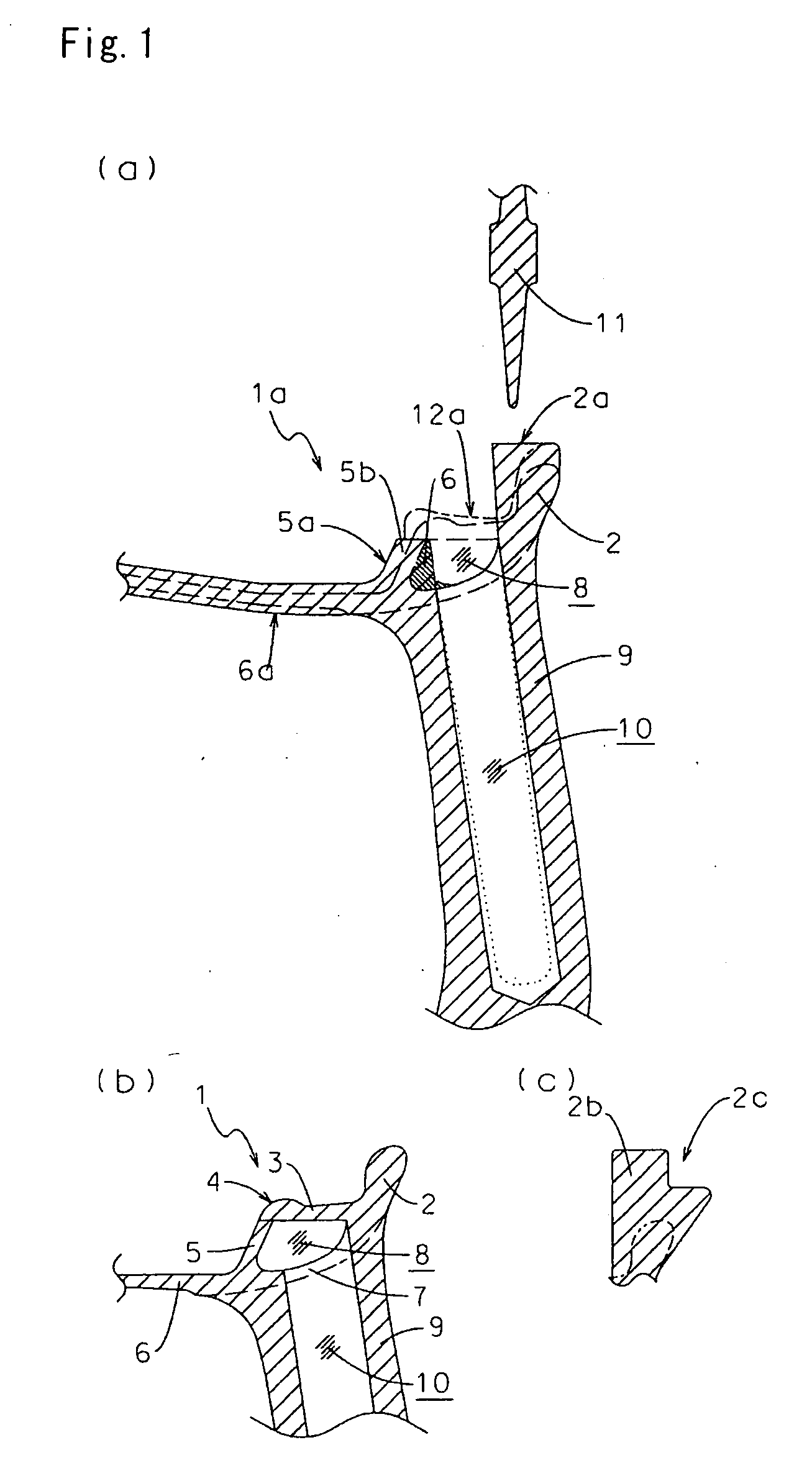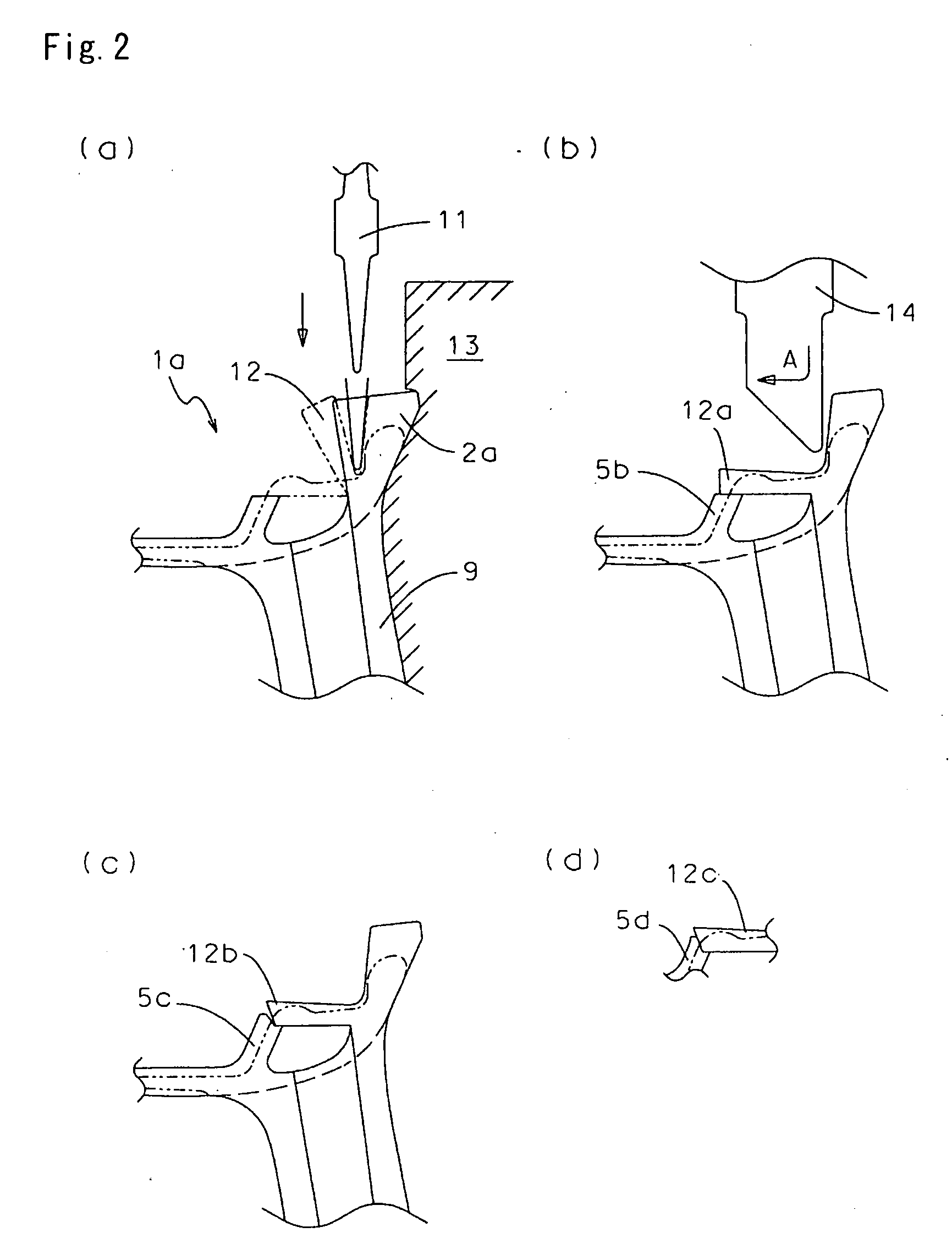Method of manufacturing light-alloy wheel for vehicle and the wheel
a technology of light alloys and wheels, applied in the field of manufacturing a light alloy automotive wheel, can solve the problems of increasing the weight of the rim, increasing the unsprung weight, and affecting the steering performance, so as to facilitate the ingress and egress of casting cores or drills, reduce thermal strain, and facilitate cutting.
- Summary
- Abstract
- Description
- Claims
- Application Information
AI Technical Summary
Benefits of technology
Problems solved by technology
Method used
Image
Examples
embodiment 1
[0018]FIG. 1(b) is a sectional view of a completed outer rim portion 1, wherein reference numeral 2 denotes an outer rim flange, 3 a bead seat, 4 a hump, 5 a rim well rising portion, 6 a rim well, 7 a rim outer shell portion, and 8 an annular hollow portion. Reference numeral 9 denotes a spoke, which makes up a disc portion. Reference numeral 10 denotes a spoke hollow portion, which is formed using a core in the case of casting, or by machining the sport firstly formed solid using a drill or the like.
[0019]FIG. 1(a) is a sectional view showing a cast outer rim material 1a, and a spoke hollow portion 10 is formed by drilling. A broken line shows a hollow portion that is to be formed using a core during casting. Compared to an outer rim flange 2, an excess thickness is formed on a flange precursor 2a for forming the outer rim flange 2. In addition, an annular flange molded body 5a for forming a rim well rising portion 5 has a trapezoidal cross section and makes up a rim well rising p...
embodiment 2
[0021]FIG. 3 shows how to manufacture the outer rim 1 using a forging method. FIG. 3(a) is a vertical sectional view showing a state in which when forging a spoke portion 9, an outer rim precursor 15 is forged integrally with the spoke portion 9, an outer rim portion which will be completed being shown by chain lines. FIG. 3(b) shows a state in which spinning is applied to the outer rim precursor 15, so as to form a flange precursor 2b, a rim well precursor 6b and a rim well rising precursor 5c. Furthermore, drilling for making a hole is applied to the spoke portion 9 to form a spoke hollow portion 10, and a hatched portion 6a is cut to be removed along the full circumference thereof so as to form an internal surface of the rim well rising portion precursor 5c. FIG. 3(c) shows a state in which a groove 16 is cut in the flange precursor 2b, and the spinning roller 11 is then pressed against the groove 16 so formed, so as to form the bead seat precursor 12a in the manner that has been...
embodiment 3
[0022] In preparing an outer rim portion 1 having an annular hollow portion provided therein, another mode for carrying out the invention will be described with respect to the arrangement of a predetermined amount of material and shape thereof for forming an outer and inner rims on a circumferential edge of a disc portion such as a spoke to which a certain design is imparted. FIG. 4(a) shows a cross section of a rim precursor 15a which is forged or cast, and hatching is imparted thereto. In the case of the rim precursor 15a being forged, drilling is applied to a spoke 9a which makes up a disc portion so as to form a spoke hollow portion 10a. In the case of the rim precursor 15a being cast, a core may be used to form the spoke hollow portion 10a. The spinning roller 11 is brought into press contact with the rim precursor 15a so as to tear it open, and part of the rim precursor is caused to fall in a sloping fashion to a position indicated by a chain double-dashed line. Furthermore, a...
PUM
| Property | Measurement | Unit |
|---|---|---|
| width | aaaaa | aaaaa |
| thickness | aaaaa | aaaaa |
| diameter | aaaaa | aaaaa |
Abstract
Description
Claims
Application Information
 Login to View More
Login to View More - R&D
- Intellectual Property
- Life Sciences
- Materials
- Tech Scout
- Unparalleled Data Quality
- Higher Quality Content
- 60% Fewer Hallucinations
Browse by: Latest US Patents, China's latest patents, Technical Efficacy Thesaurus, Application Domain, Technology Topic, Popular Technical Reports.
© 2025 PatSnap. All rights reserved.Legal|Privacy policy|Modern Slavery Act Transparency Statement|Sitemap|About US| Contact US: help@patsnap.com



